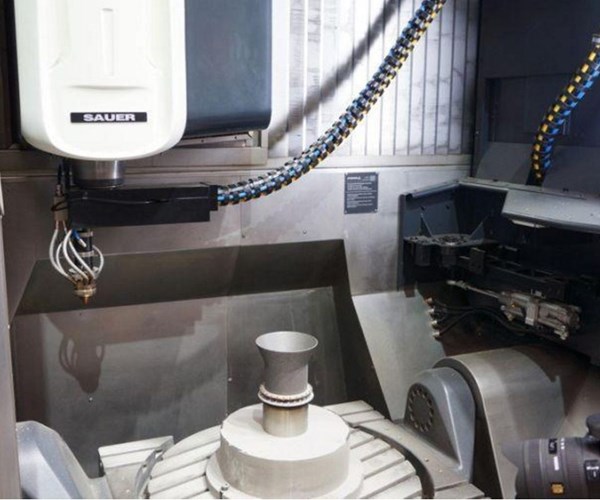Additive + Subtractive Won’t Need Further CNC Advances
Today’s control technology is ready for these machines, and for more challenging integrations than this.
Share






A machine such as this one, which combines additive manufacturing with subtractive machining through five axes of motion, can be controlled using today’s existing CNC technology.
So-called “hybrid” machine tools, which combine additive manufacturing with CNC machining, might prove to be the most effective way for many manufacturers to implement additive manufacturing. The adoption and development of these machines is liable to advance. But even so, CNC technology will not have to race to keep up, says Randy Pearson, international business development manager for Siemens. He points out that existing, standard CNCs have been implemented on hybrid machines today. This level of control technology is up to the task of running the multi-process machines, he says.
Indeed, more challenging unions have already been achieved. Siemens has demonstrated a machine tool and robot under the coordinated control of a single CNC. Part of the challenge in this is that the robot and machine tool obey different command languages. Uniting metal cutting with additive manufacturing does not feature this challenge, he says, because the additive process uses just a modified set of codes within the language of the machine tool. Seen in this light, additive is a natural function for the machine tool to take on, and the control is ready for this addition.
Pearson says, “Whether the parameters involve laser gases, powdered metal deposition and inert atmosphere vacuum or five-axis rotation of a milling head or rotary table, the function of the control remains nearly identical. In this way, a single control can run two varying technologies for fabrication and chip cutting, either on a single channel or on a two-channel unit.”
And as previous successes have shown, he adds, those two technologies could even be used in tandem with a robot. Indeed, the company has come very close to this in a recent partnership that has developed an .
Related Content
-
The Cool Parts Showcase Seeks Innovative 3D Printed Parts
Do you solve problems with 3D printing? Enter your 3D printed parts in this contest from The Cool Parts Show.
-
Digitalization and Done-In-One Reign Supreme at BIEMH 2024
European manufacturers may have a different balance of markets than their U.S. counterparts, but the practical challenges they must overcome are often similar — as are the solutions.
-
Push-Button DED System Aims for Machine Shop Workflow in Metal Additive Manufacturing
Meltio M600 metal 3D printer employs probing, quick-change workholding and wire material stock to permit production in coordination with CNC machines.














